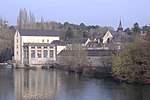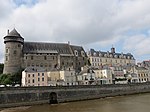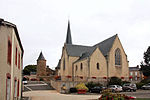Romano-Gallic Baths of Entrammes
Ancient Roman baths in FranceBuildings and structures completed in the 2nd centuryDiablintesMonuments historiques of Pays de la LoireRuins in Pays de la Loire ... and 1 more
Tourist attractions in Mayenne

The Roman-Gaul Baths of Entrammes (Thermes gallo-romains d'Entrammes in French) is a complex of Gallo-Roman thermal baths (thermae) in Entrammes, Mayenne, France. The baths were partially incorporated into a church with the hypocaust surviving below the new structure. The remains were discovered in 1987.
Excerpt from the Wikipedia article Romano-Gallic Baths of Entrammes (License: CC BY-SA 3.0, Authors, Images).Romano-Gallic Baths of Entrammes
Place de l'Église, Laval
Geographical coordinates (GPS) Address Nearby Places Show on map
Geographical coordinates (GPS)
| Latitude | Longitude |
|---|---|
| N 48.023055555556 ° | E -0.76972222222222 ° |
Address
Église Saint-Siméon-Stylite
Place de l'Église
53970 Laval
Pays de la Loire, France
Open on Google Maps







